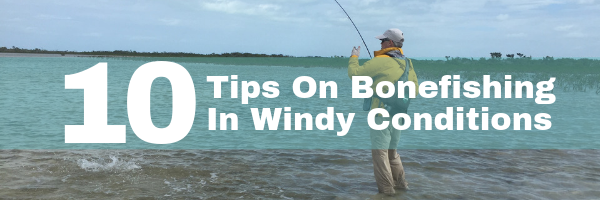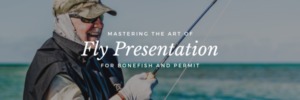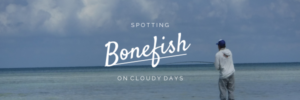Given the stealthy, savvy nature of bonefish, bringing a big bone in can be a major challenge, even in ideal conditions.
Unfortunately, however, not all fisherman have the benefit of calm waters, clear visibility, and zero wind. In fact, wind is something that you’re very likely to encounter when taking to the flats. The good news is that when you master the art of casting into the wind, you’ll often find yourself fishing with very little competition from your peers. Following are ten tips to keep you hauling prize-worthy bones into the skiff, even when the wind is raging.
1. Use A Shorter Leader
Keeping your leader short is essential for both maximizing control and ensuring that you aren’t alerting your prey to your presence. Being able to straighten the leader out when presenting your fly is a large part of remaining inconspicuous. Long leaders are hard to straighten out when the pressure is on, but they’re even harder to straighten out when the wind is fighting you. While commercial leaders generally run between 10 and 14 feet in length, we recommend cutting yours to just 6 to 9 feet, particularly on windy days.
2. Use A Heavier Fly
A heavy fly is always the best choice in windy conditions. When the wind is doing its worst, natural disturbances on the surface of the water will mask large splashes and a sloppy entry. The additional weight of lead eyes will help your fly sink faster despite wind-related water disturbances. This means that you can get your fly in front of bonefish as quickly as possible, thereby experiencing fewer missed opportunities.
3. Go For A Heavier Rod And Line Size
While the 8 weight is the typical choice for bonefishing, the 9 weight is going to be the best option for windy conditions. Efforts to make a delicate presentation won’t do you much good if you’re never able to actually land your fly in front of the bone you’re pursuing. The 9 weight will help you get it there. You may even want to try over-lining the rod as well. Any additional weight will make it easier to load.
4. Vary The Loop Size
Tight loops and line speed make all the difference when casting in strong winds. This is because a small loop can cut through the wind more efficiently than can a wide one. Make sure that your rod is tracking in a straight line to create a tight loop.
5. Practice
Your trip to the flats shouldn’t be the very first time that you try casting into the wind. Work on throwing tight casts into the wind while minimizing false casts. You also want to work at every angle so that the wind isn’t always at your back or blowing straight at you.
6. Adjust Your Casting Plane
The more versatile you are; the more ready you’ll be for rapidly changing wind conditions. Practice casting from your hips, your shoulder, and at other elevations. With time, you’ll be able to recognize the perfect casting plane for every situation.
7. Avoid Shooting Your Line Into The Wind
Never shoot your line into the wind. The second you release your line to shoot, the rod will unload. More importantly, it will be at the mercy of the wind. Conversely, not shooting lets the rod remain loaded until the casting stroke is complete, thereby allowing the fly to turn over.
8. Use the Belgian Cast
The Belgian Cast or the Torrie Mellow Cast is great for times when the wind isn’t actually blowing right at you. This cast will help you land the fly right on target. To perform the Belgian Cast, make your back cast low to the water and from the side. You can cast over your head in the traditional manner when making a forward cast. Changing planes like this will keep the fly away from you so that it doesn’t land right on your head.
9. Double And Triple Hauling
If you have experience casting in windy conditions, consider trying a double or triple haul. This will help you turn your fly over when attempting to punch a cast in particularly strong wind. Once you’ve finished your haul on a forward cast, haul a third time at the very end. This will put more energy into the system so that the fly either dives straight down or turns obediently over.
10. Wear The Proper Attire
You have a much higher likelihood of hooking yourself in windy conditions, so wearing the right clothing is essential. You’ll also be using a lot more force to drive your casts through the wind, which will make any impalement all the more dangerous and painful. Wear a snug-fitting hat, a durable jacket, and reliable eye protection.









